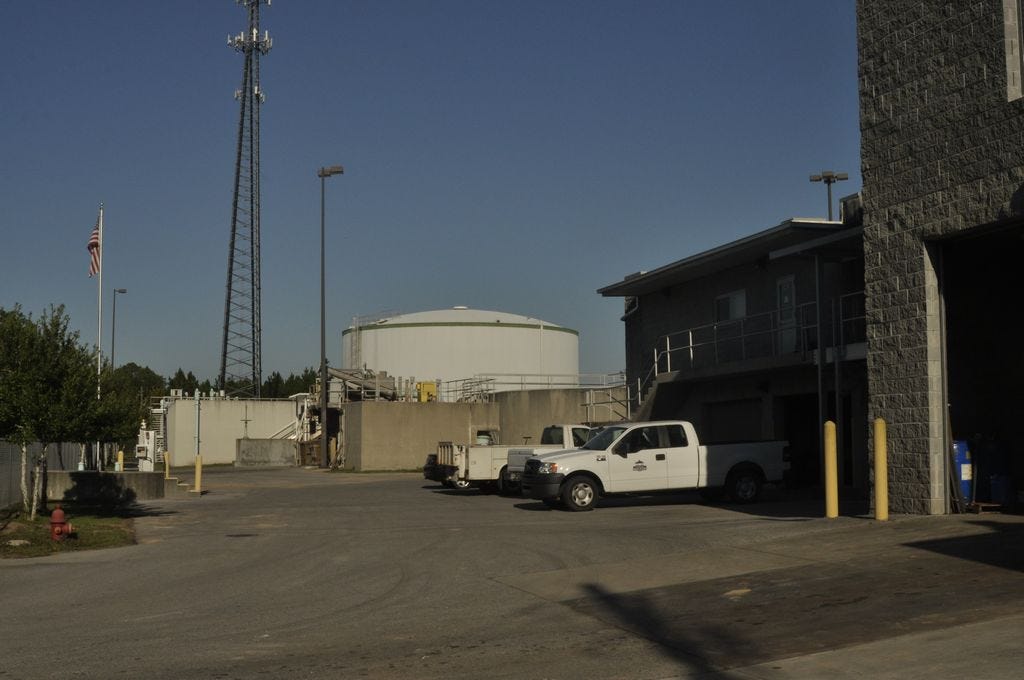
There are several reasons as to why a new wastewater facility is needed for not only the City of Milton, but for a good portion of northern Santa RosaCounty, which is why elected officials and city staff continue to seek legislative support in completing the project. Two of the major concerns stem from environmental unease and ongoing economic development.
Although the city has steadily worked on bringing a new wastewater treatment plant to East Milton for the past eight years, City Manager Brian Watkins suggests the need for a new facility might occur earlier than expected.
“Right now, we are at about 70 percent capacity” he said. “We are permitted for 2.5 million gallons a day, our average daily flow is about 1.75 million.”
The city’s current facility is located off Henry Street near the BlackwaterRiver, while a new facility is being planned near the industrial park on property acquired from Santa RosaCounty. While 90 percent of the design plans have been completed for the new plant, the city has also submitted a permit to the Florida Department of Environmental Protection for approval.
Watkins said the need for another plant became apparent prior to the recent recession when housing developers were looking build subdivisions. Now the local housing market is showing signs of recuperation. One example is the growth of several subdivisions, including Rustic Ridge, Magnolia Bend and The Preserve.
With the continuing growth, Watkins said the staff estimates the current treatment plant will reach the 2.5 million gallons a day maximum by 2025.
“According to DEP regulations, three years prior to that you have to be in their office with your completed plans in hand,” Watkins said.
However, if more developments continue to make their way to the north end of the county, the estimated timeline could arrive earlier than anticipated. As an example, Watkins said if an incoming manufacturing development needing a large amount of waste water services a day could drastically change the timeline.
“One plant that does 250,000 gallons a day. If you add that we are not at 1.7 (million gallons) anymore we are at 2 (million gallons per day),” he said. “It can be that fast that capacity can be used up.”
There is also a sense of urgency from an environmental perspective. A new treatment plant would be moved away from the BlackwaterRiver where the current facility has an effluent discharge going into the river, which according to Watkins, in no way negatively impacts the river.
According to a 2007 waste water effluent based study, conducted by the CH2 Hill, the current facility’s effluent discharge is considerably cleaner than the water found in the river, Watkins said.
Regardless of the cleanliness of the effluent coming from the treatment facility , Watkins said many government agencies and environmental organizations are not fond of any effluent discharge, like storm water runoff.
In addition, government agencies like the DEP and Environmental Protection Agency are looking to increase standards for surface water discharge. The city’s other option would be to stay at the current location and add another costly treatment component to the effluent output.
Once built, a new treatment facility would also allow for increased waste water usage. Should the need arise, a new facility could handle up to 8 million gallons per day, Watkins said.
These pressing concerns are just a couple of reasons why Council Member Ashley Lay is taking an initiative to place the item before legislation along with both the north and south portions of the Riverwalk and restoring the historic Mt.PilgrimMissionaryBaptistChurch.
Lay said the plan is to attend the upcoming session, potentially with other elected officials and city staff, for the legislative delegation in Tallahassee with the intent to present each project and answer any questions.
“Our delegation will also connect us with committees and organizations related to our projects during our visit, so we can work together to meet our communities needs,” Lay said.
While seeking legislative funding is a priority, the city is also seeking additional financial support sources from other state programs and grants, which could assist in paying off portions of the project, Watkins said.
“The city realizes consistency is important as we try to lay the groundwork for the funding of these items,” Lay said.
This article originally appeared on Santa Rosa Press Gazette: Need for East Milton Wastewater facility approaching, officials say
